Learninsta presents the core concepts of Biology with high-quality research papers and topical review articles.
Inflorescene Types and its Characteristics
Have you seen a bouquet being used during functions? Group of flowers arranged together on our preference is a bouquet. But an inflorescence is a group of flowers arising from a branched or unbranched axis with a definite pattern.
Function of inflorescence is to display the flowers for effective pollination and facilitate seed dispersal. The grouping of flowers in one place gives a better attraction to the visiting pollinators and maximize the energy of the plant.
Types of Inflorescence
Based On Position
Have you ever noticed the inflorescence arising from different positions? Where is the inflorescence present in a plant? Apex or axil? Based on position of inflorescences, it may be classified into three major types. They are,
Terminal:
Inflorescence grows as a part of the terminal shoot. Example: Raceme of Nerium oleander.
Axillary:
Inflorescence presents in the axile of the nearest vegetative leaf. Example: Hibiscus rosa-sinensis
Cauliflorous:
Inflorescence developed directly from a woody trunk. Example: Theobroma cocoa, Couraupita guinensis. Observe the inflorescence of Jackfruit and Canon ball tree. Where does it arise?
Based on Branching Pattern and Other Characters
Inflorescence may also be classified based on branching, number and arrangement of flowers, and some specialized structures.
I. Indeterminate (Racemose)
II. Determinate (Cymose)
III. Mixed Inflorescence:
Inflorescence of some plants show a combination of indeterminate and determinate pattern.
IV. Special Inflorescence:
Inflorescence which do not confine to these patterns
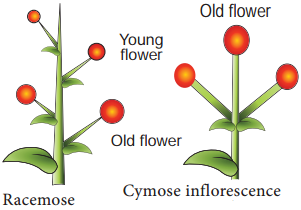
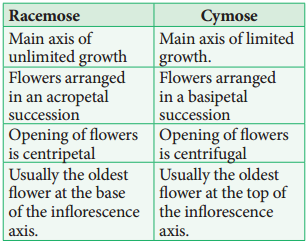
I. Racemose
The central axis of the inflorescence (peduncle) possesses terminal bud which is capable of growing continuously and produce lateral flowers is called Racemose inflorescence. Old flowers are at the base and younger flowers and buds are towards the apex. It is further divided into 3 types based on growth pattern of main axis.
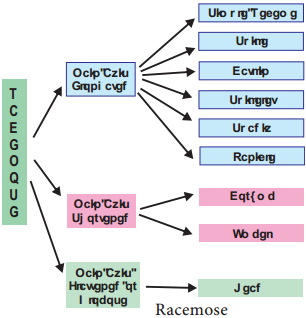
1. Main Axis Elongated
The axis of inflorescence is elongated and contains pedicellate or sessile flowers on it. The following types are discussed under main axis elongated type.
a. Simple Raceme:
The inflorescence with an unbranched main axis bears pedicellate flowers in acropetal succession. Example: Crotalaria retusa, Mustard.
b. Spike:
Spike is an unbranched indeterminate inflorescence with sessile flowers. Example: Achyranthes.
c. Spikelet:
Literally it is a small spike. The Inflorescence is with branched central axis. Each branch is a spikelet. Sessile flowers are formed in acropetal succession on the axis.
A pair of inflorescence bracts called glumes is present at the base. Each sessile flower has a lemma (bract) and a palea (bracteole). Tepals reduced to colourless scaly leaves (lodicule). Each flower has stamen and pistil only. Example: Paddy, Wheat.
d. Catkin:
Pendulous spikes with a long and drooping axis bearing small unisexual or bisexual flowers. It is also called ament. Example: Acalypha hispida, Prosopis juliflora.
e. Spadix:
An inflorescence with a fleshy or thickened central axis that possesses many unisexual sessile flowers in acropetal succession. Usually female flowers are found towards the base and male flowers are found at the apex. Entire inflorescence is covered by a brightly coloured or hard bract called a spathe. Example: Amorphophallus, Colocasia.
f. Panicle:
A branched raceme is called panicle. Example: Mangifera, neem. It is also called Compound raceme or Raceme of Racemes.
2. Main axis shortened:
Inflorescence with reduced growth of central axis. There are two types, namely corymb and umbel.
a. Corymb:
An inflorescence with shorter pedicellate flowers at the top and longer pedicellate flowers at the bottom. All flowers appear at the same level to form convex or flat topped racemose inflorescence. Example: Caesalpinia. Compound corymb: A branched corymb is called Compound corymb. Example: Cauliflower.

b. Umbel:
An inflorescence with indeterminate central axis and pedicellate flowers arise from a common point of peduncle at the apex. Example: Allium cepa.
Compound Umbel:
It is a branched umbel. Each smaller unit is called umbellule. Example: Daucas carota, Coriandrum sativum.
3. Main Axis Flattened:
The main axis of inflorescence is mostly flattened (convex or concav) or globose. A head or capitulum is determinate or indeterminate, group of sessile or sub sessile flowers arising on a receptacle, often subtended by an involucre.
a. Head:
A head is a characteristic inflorescence of Asteraceae and is also found in some members of Rubiaceae and Mimosaceae. Torus contains two types of florets:
- Disc floret or tubular floret
- Ray floret or ligulate floret. Based on the type of florets present, the heads are classified into two types.
(i) Homogamous Head:
This type of inflorescence exhibits single kind of florets. Inflorescence has disc florets alone. Example: Vernonia, Ray florets alone. Example: Launaea.
(ii) Heterogamous Head:
The inflorescence possesses both types of florets. Example: Helianthus, Tridax.
Disc florets at the centre of the head are tubular and bisexual, whereas the ray florets found at the margin of the head which are ligulate and pistilate (unisexual).
II. Cymose Inflorescence
Central axis stops growing and ends in a flower, further growth is by means of axillary buds. Old flowers present at apex and young flowers at base.
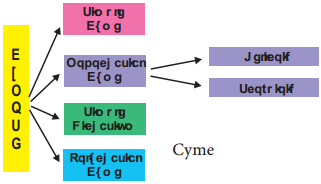
1. Simple Cyme (Solitary):
Determinate inflorescence consists of a single flower. It may be terminal or axillary. Example: terminal in Trillium grandiflrum and axillary in Hibiscus.
2. Monochasial Cyme (Uniparous):
The main axis ends with a flower. From two lateral bracts, only one branch grows further. It may be Helicoid or Scorpioid.

a. Helicoid:
Axis develops on only one side and forms a coil structure atleast at the earlier development stage. Example: Hamelia, potato.
b. Scorpioid:
Axis develops on alternate sides and often becomes a coiled structure. Example: Heliotropium.
3. Simple Dichasium (Biparous):
A central axis ends in a terminal flower; further growth is produced by two lateral buds. Each cymose unit consists of three flowers of which central one is old one. Ths is true cyme. Example: Jasminum.
4. Compound Dichasium:
It has many flowers. A terminal old flower develops lateral simple dichasial cymes on both sides. Each compound dichasium consists of seven flowers. Example: Clerodendron. A small, simple dichasium is called cymule
5. Polychasial Cyme (Multiparous):
The central axis ends with a flower. The lateral axis branches repeatedly. Example: Nerium
III. Mixed Inflorescence
Inflorescences in which both racemose and cymose patterns of development occur in a mixed manner. It is of the following two types.
1. Thyrsus:
It is a ‘Raceme of cymes’. Indefinite central axis bears lateral pedicellate cymes, (simple or compound dichasia). Example: Ocimum.
2. Verticillaster:
Main axis bears two opposite lateral sessile cymes at the axil of the node, each of it produces monochasial scorpioid lateral branches so that flowers.
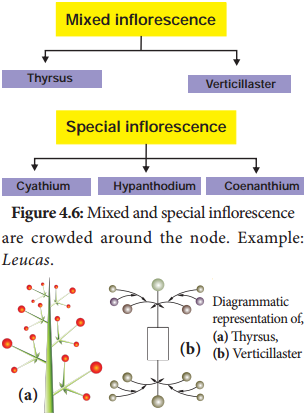
IV. Special Inflorescence
The inflorescence that do not show any of the development pattern types are classified under special type of inflorescence.
1. Cyathium:
Cyathium inflorescence consists of small unisexual flowers enclosed by a common involucre which mimics a single flower. Male flowers are organised in a scorpioid manner. Female flower is solitary and centrally located on a long pedicel.
Male flower is represented only by stamens and female flower is represented only by a pistil. Cyathium may be actinomorphic (Example: Euphorbia) or zygomorphic (Example: Pedilanthus). Nectar is present in involucre.
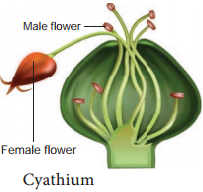

2. Hypanthodium:
Receptacle is a hollow, globose structure consisting of unisexual flowers present on the inner wall of the receptacle. Receptacle is closed leaving a small opening called ostiole which is covered by a series of bracts. Male flowers are present nearer to the ostiole, female and neutral flowers are found in a mixed manner from middle below. Example: Ficus sp. (Banyan, Fig and Pipal).
3. Coenanthium:
Circular disc like fishy open receptacle that bears pistillate flowers at the center and staminate flowers at the periphery. Example: Dorstenia.